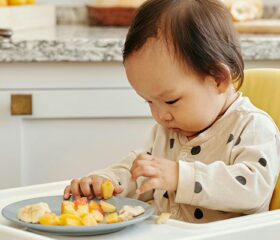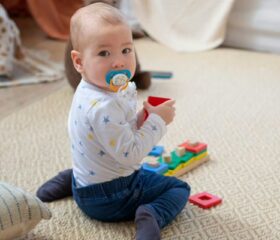How Many Bones Does Your Baby Have?
Believe it or not, your baby has almost 100 more bones than you do.

Babies have around 300 bones at birth, compared to the 206 bones an adult has. 1 This difference comes from how a baby’s skeletal system develops, starting in the womb and continuing throughout childhood.
Learn how your baby’s bones form and grow, plus what you can do to support her skeletal development.
Why do babies have more bones than adults?
Babies have more bones than adults thanks to cartilage. This flexible, rubbery tissue makes up much more of a newborn’s skeleton than an adult’s. 1
Since cartilage is softer than bone, it gives your baby more flexibility in the womb, letting her curl up comfortably in this increasingly tight space.
One notable example of cartilage in newborns is the kneecap (patella), which starts as cartilage and gradually hardens into bone when your baby is between 2 and 6 years old. 2
Because so much of your baby’s skeleton is composed of cartilage, her actual bones are separated by it, which means she has much more of them than she will when she’s an adult.
How cartilage transforms into bone
While your baby’s in the womb, her skeleton undergoes a process called ossification, where her cartilage is gradually replaced with bone. 3
After she’s born, her skeleton will continue developing, and many of her separate bones will fuse together. For example, her skull has multiple plates that will merge over time. This process continues well into adolescence, eventually forming the 206 bones she’ll have as an adult. 4
As your child grows, her bones will continue strengthening through a process called bone remodeling. 5 Osteoblasts (bone-building cells) deposit new material, while osteoclasts break down old bone. This cycle ensures that her bones remain strong and adaptable.
What are your baby’s bones made of?
Both your and your baby’s bones are composed of several layers, each with a specific function: 1
- Periosteum: A thin but dense outer membrane that nourishes the bone and supports growth and repair.
- Compact bone: This hard outer layer provides strength and structure.
- Cancellous bone (spongy bone): The bone’s porous inner layer helps maintain strength while absorbing shock and reducing weight.
- Bone marrow: This soft tissue inside the bones produces blood cells and stores fat.
All these components will come together to create your baby’s skeletal system, which will grow, strengthen, and repair itself over time. 4
How your baby’s bones develop during pregnancy
Your baby’s skeletal system begins developing very early on in your pregnancy, with key milestones coming at these points:
- 3 weeks pregnant: Your baby’s mesoderm, a layer of embryonic cells, begins to form. The mesoderm lays the foundation for her bones, cartilage, muscles, and internal organs. 6
- 6 weeks to 12 weeks pregnant: Your baby’s arms and legs begin to form, and tissue grows that will eventually become her spine and other bones. 7
- Second trimester: Your baby’s muscle tissue and bone continue to form. Her bone marrow will start to form red blood cells. 8
- Third trimester: Your baby begins storing calcium, which aids bone development. Her bones are fully developed at this point, but they’re still soft. 7
Spinal development
Your baby’s spine is the cornerstone of her skeletal integrity and movement. The spine begins to form early on in pregnancy from small and segmented structures called somites. 9
Somites eventually develop into the vertebrae (the individual bones of your baby’s spinal column), rib cage, muscles, and skin.
The role of growth plates
Long bones, like the femur and humerus, grow from special areas called growth plates. 10 These sections of cartilage, located near the ends of bones, allow your child’s bones to lengthen until she reaches adulthood.
Your baby’s bones are more fragile than yours
Your baby’s growth plates are softer and more fragile than mature bone. This makes her more susceptible to fractures than an adult. 2 Don’t let this stress you out—just be extra careful!
Your baby’s skull
Your baby’s skull is designed for flexibility, so that it can withstand birth and rapid brain growth. Consequently, instead of the single solid bone that it will eventually become, it consists of several plates connected by soft spots called fontanelles.
The posterior fontanelle (at the back of your baby’s head) usually closes between 4 weeks old and 2 months old. 11 The anterior fontanelle (at the top of her head) stays open until she’s 7 months old to 19 months old to allow for brain expansion. 11
Fontanelles allow your baby’s skull to compress during birth, making her passage through the birth canal easier. 12 It will also accommodate her brain’s rapid growth, which will triple in weight in the first three years of her life.
However, your baby’s brain will continue growing until she’s around 16 years old, and her skull will keep developing until she’s about 20. 13
How to support your baby’s bone health
For your baby to build strong bones, she’ll need the right nutrients. Here’s how you can support your baby’s growing bones during pregnancy and after she’s born:
During pregnancy
The best way to support your baby’s bone development while she’s in the womb is by maintaining a healthy pregnancy diet that’s full of:
- Calcium: Aim to get 1,000 mg daily from dairy, leafy greens, sardines, and fortified foods. 14 15 You could also try calcium chews to boost your intake, especially if you’re not getting enough from your diet alone.
- Phosphorus: Alongside calcium, phosphorus aids the formation of bones and teeth. Believe it or not, it’s actually the second most abundant mineral in your body, making up 1% of an average person’s total body weight. Make sure you’re getting enough by consuming plenty of meat, fish, dairy, nuts, and beans. 16
- Vitamin D: Vitamin D helps your body absorb calcium well. Your body can produce it when you get exposure to sunlight, and you can also find it in eggs, fish, and fortified dairy. 17 If you’re lacking in vitamin D during pregnancy, your newborn could be at risk of abnormal bone growth, fractures, or a bone disease called rickets, so talk to your doctor about supplements. 17
If you’re struggling to get enough of these essential vitamins and minerals through your diet alone, chat with your doctor. They might be able to recommend supplements that’ll ensure your baby’s needs are met.
Why calcium is important for healthy bones
As you may have heard, calcium is the foundation of healthy bones. This mineral, along with vitamin D, helps build and maintain them.
Your baby’s body (as well as your own) can’t produce calcium itself—it needs to be absorbed from the foods she eats. Without enough calcium, her body will remove it from her bones, which weakens them over time and can lead to osteoporosis (a condition where bones become very fragile). 18
After birth
For guidance about supporting your baby’s bone development, talk to your pediatrician about:
- Breastfeeding or formula-feeding: Remember that breast milk or formula should remain your baby’s primary source of nutrition until she’s a year old. Either will provide her with all the calcium she needs. 19
- Vitamin D supplements: Breast milk alone may not provide enough for adequate calcium absorption, so your doctor might recommend adding a liquid supplement. 20
- Introducing solids: The transition period to solids is usually when babies can have yogurt, cheese, leafy greens, and other foods that are high in calcium, which aids in bone development. 21
Final thoughts
Your baby’s bones are more complex than you might think. That soft cartilage she starts off with lays the groundwork for the fully fused bones she’ll develop later on in life.
From pregnancy through to your baby’s childhood, you can ensure her bones grow strong with a good diet and plenty of activity.
Article Sources
- Nemours KidsHealth. "Your Bones" Retrieved October 27, 2025.
- StatPearls. "Anatomy, Bony Pelvis and Lower Limb, Knee Patella" Retrieved October 27, 2025.
- The International Journal of Biochemistry & Cell Biology. "Endochondral ossification: how cartilage is converted into bone in the developing skeleton" Retrieved October 27, 2025.
- StatPearls. "Anatomy, Bones" Retrieved October 27, 2025.
- MedlinePlus. "Calcium and bones" Retrieved October 27, 2025.
- StatPearls. "Embryology, Weeks 6-8" Retrieved October 27, 2025.
- MedlinePlus. "Fetal development" Retrieved October 27, 2025.
- Office on Women's Health. "Stages of pregnancy" Retrieved October 27, 2025.
- MedlinePlus. "Spondylocostal dysostosis" Retrieved October 27, 2025.
- Nemours KidsHealth. "Bones, Muscles, and Joints" Retrieved October 27, 2025.
- MedlinePlus. "Cranial sutures" Retrieved October 27, 2025.
- Cleveland Clinic. "What To Know About Baby’s Fontanelles (aka Soft Spots)" Retrieved October 27, 2025.
- Centers for Disease Control and Prevention. "Early Brain Development and Health" Retrieved October 27, 2025.
- National Institute of Arthritis and Musculoskeletal and Skin Diseases. "Pregnancy, Breastfeeding, and Bone Health" Retrieved October 27, 2025.
- Dietary Guidelines for Americans. "Food Sources of Calcium" Retrieved October 27, 2025.
- MedlinePlus. "Phosphorus in diet" Retrieved October 27, 2025.
- American Journal of Obstetrics and Gynecology. "Implications of vitamin D deficiency in pregnancy and lactation" Retrieved October 27, 2025.
- OrthoInfo. "Calcium, Nutrition, and Bone Health" Retrieved October 27, 2025.
- National Institute of Arthritis and Musculoskeletal and Skin Diseases. "Calcium and Vitamin D: Important for Bone Health" Retrieved October 27, 2025.
- Centers for Disease Control and Prevention. "Vitamin D and Breastfeeding" Retrieved October 27, 2025.
- Centers for Disease Control and Prevention. "When, What, and How to Introduce Solid Foods" Retrieved October 27, 2025.







